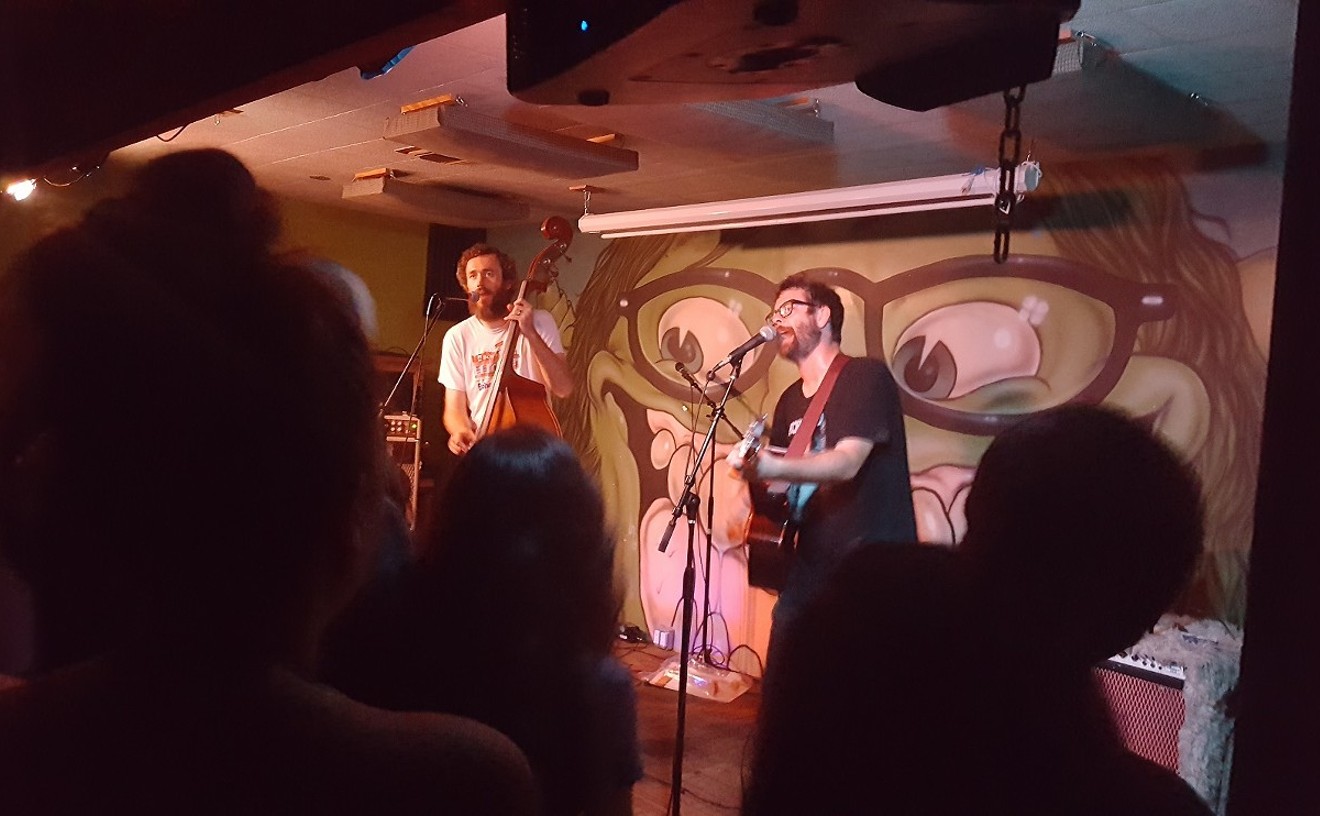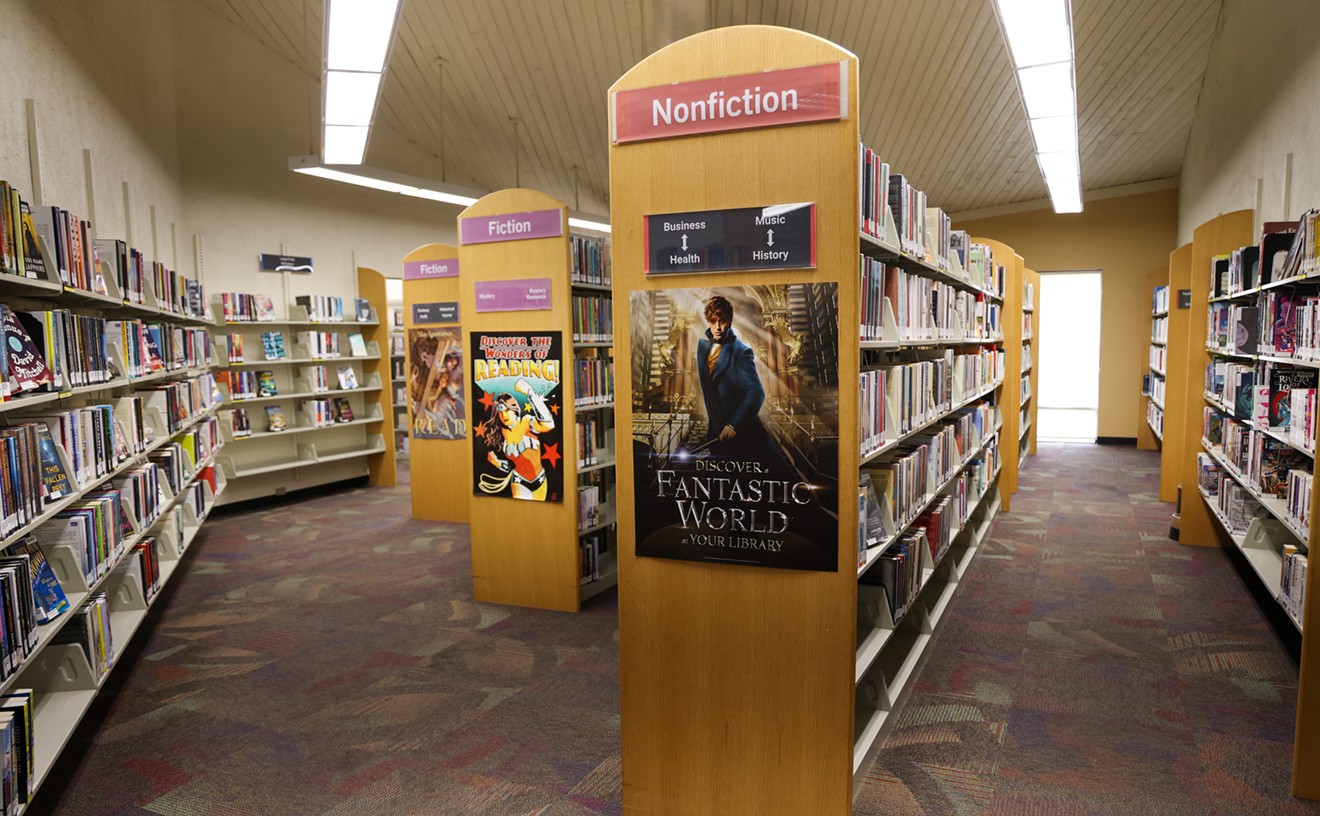From the second-story patio of Phoenix College's art building in downtown Phoenix, photographer Bob Carey can point to the hospital where he was born, the neighborhood where he grew up, and the three or four houses he lived in after high school and college.
The Phoenix native moved to New York in the early 2000s, but he still remembers his first big show at RoxSand, a restaurant in Phoenix, long before he started taking calls from The Today Show, Wired, Carson Daly, and Yahoo! News (to name a few) about his latest series, "The Tutu Project."
Since his project was featured on national news earlier this spring, he says, his Facebook page has exploded, e-mails have poured in, and his phone won't stop ringing.
On a recent Thursday, Carey gave a lecture to an art class at Phoenix College. He had an hour or so to talk before shooting off to dinner with a friend at AZ88 and then back to a friend's house to pack his suitcase (again) and catch an early-morning flight.
To be honest, he says, it's all totally overwhelming.
The 51-year-old photographer is big guy with a disarming smile. He's known to skip around subjects in conversation and is more than happy to talk about his latest projects, what his weekend plans are, and how fast his uncle used to drive down the highway from Globe to Phoenix.
Carey made a name for himself in commercial photography and fine art photography that features his emotive, isolated self-portraiture. For a self-titled series that's been featured everywhere from a university museum to a fancy restaurant (more on that later), Carey shaved his entire body, painted himself silver, and tightly wrapped his head and torso with thick fishing line. His skin burst between the tightly wrapped wire, his facial expressions are excruciating, but he says the fishing line — and the series — was all about keeping himself together ("Unhairy Carey," Kathleen Vanesian, October 14, 1999).
Photography was a passion he discovered during a dark time, and he continued to use it as a means of therapy and self-expression. His outlet became increasingly important when his wife, Linda, was diagnosed with breast cancer in 2003.
And though his latest series, "Ballerina," is fresh to his new-found national audience, Carey's stiff, pink tulle tutu has a long, local history.
In 2002, Ballet Arizona asked Carey and other local artists to make photographs that expressed what ballet meant to them. It was a funny experience, Carey says, because he'd never been to the ballet.
The photograph that resulted was simple and striking. It featured a half-naked Carey, hunched and covered in silver mica paint. He wore only the signature ballerina's accessory. The image was used on mugs and posters, in pamphlets and fundraising campaigns.
Carey's "Ballerina" series grew out of that photograph and out of his experience with self-portraiture. Armed with a van full of lighting equipment, a few cameras, and a clunky shutter remote control, he ventured to the places he knew best. He often brought his wife or assistant (New Times contributor Jackie Mercandetti) to help make sure the camera stayed steady or explain his project to the police officers who often arrived on the scene to question him.
Carey stood among enormous corn stalks in a field in Queen Creek and laid motionless in an empty parking lot on ASU's Tempe campus. His series expanded and included portraits from coast to coast, on vessels, in trees, on neighborhood basketball courts, and in the middle of endless rolling hills.
Carey's canvas and world is enormous and beautifully intimidating. And in his photographs, he is almost always alone.
During his recent visit here, Carey sits at a metal table on the Phoenix College patio and frantically searches for a way to charge his phone. His laptop battery dies a few minutes after he opens it to respond to an e-mail.
From a bag full of cameras, wires, and headphones, he pulls out a backup phone charger, never skipping a beat in a conversation about Phoenix. He plugs in, pointing to the distant McDowell Mountains. He talks about how he and his friends used to park at the base, run up to the top, and hang out.
Carey attended Scottsdale Community College before switching to Arizona State University. "I could have been a pilot," he says, "I'm from a family of pilots." Instead, he signed up for photography classes.
He traces his photography skills back to the day his father bought him a camera after he'd been in a skateboarding accident as a teenager. He played football for Scottsdale High and took up skateboarding when the potential of a football career was no longer interesting and too much pressure.
After that, it was all about photography.
It was at ASU that he studied under local photographer James Hajicek (now a close friend) and met his soon-to-be wife through his neighbors on busy Ash Avenue in Tempe.
"I met Linda at a party," he says, "I saw her sitting at the end of the bar and knew it was all over."
Hajicek and his wife, fellow photographer Carol Panaro-Smith, fondly call Bob their "big son who never left town — until he did." Hajicek, Panaro-Smith, and Carey grew to know each other in and out of the classroom. Carey says he knew he wanted to be a commercial photographer but also wanted to explore art, a curiosity Hajicek says landed him a few puzzled looks from the fine art program. But Carey continued to study both — he worked in commercial studios, took classes from fine art photographers, and found an accessible, beautiful balance at the intersection. Both styles and sets of rules continue to play huge roles in his work.
"Bob's photographs function on so many levels," Hajicek says. "He's an incredible formalist in terms of graphic balance, and he understands how things work on a plane. But from those basics, you can keep peeling the layers back. Bob explores all sorts of differences — being a male in a large, pink tutu, for one — to get to his point: We're all the same. He's a very special photographer."
After he graduated, Carey convinced Linda to help out with his commercial photography studio, and when chef Roxsand Scocos noticed his work and asked him to fill the walls at restaurant at Biltmore Fashion Park, he started printing.
Carey photographed Scocos and created a collection of his own portraits, which he printed in large format and set in custom-welded aluminum frames. "RoxSand's was where local artists really got noticed," he says. "And it is absolutely where I began."
His work stayed in the restaurant for seven years until it closed in 2003. Carey's had solo shows at Tempe's ASU Art Museum, downtown Phoenix's Bokeh Gallery, and Gilbert's Art Intersection (run by Panaro-Smith).
He acknowledges that his body of portraits has been dark but notes that the work (including pre-tutu) carried him through his wife's and sister's diagnoses, and the deaths of his two dogs. And when he and Linda moved to New York to make a go for his career in the big city, he decided to take his tutu with him.
Carey's on his second tutu (the first was worn out and replaced by one he made with his sister). And while the themes of pain and vulnerability felt in his self-portraits and his "One Image Every Day" project are apparent in his latest series, he emphasizes the humor in this new work. It's the humor that's pushed him to climb palm trees, lay in the middle of a busy New York City intersection, and stand in below-freezing temperatures, all while wearing a tutu. It's the humor, he says, that carries him and his wife through her second round of treatments and the "miracle" prescriptions she takes.
The "Ballerina" series wasn't always about breast cancer, he says. But when he threw himself into his work while his wife was undergoing treatments, there was an obvious connection. He was approached with an opportunity to raise money for research. It was then that everything fell into place.
This fall, Carey will self-publish Ballerina, a book that includes the collection of "The Tutu Project" portraits, as well as a foreword by Amy Arbus and backstory by New Times contributor Kathleen Vanesian. The net proceeds from sales of the book will go directly toward breast cancer organizations Cancercare.org and the Beth Israel Department of Integrative Medicine Fund. His goal is to raise $75,000.
"I'm so happy that people are responding, but, of course, I'm not surprised," says Panaro-Smith. "Bob's using this series as a means of catharsis. There's so much in every photograph about being vulnerable, while also being poignant and funny and also a little sad. This series — this book — is everything that is Bob."










